Bananas vs plantains…are they actually different? Get to know the difference between plantains and bananas in this helpful guide to these tasty tropical fruits!
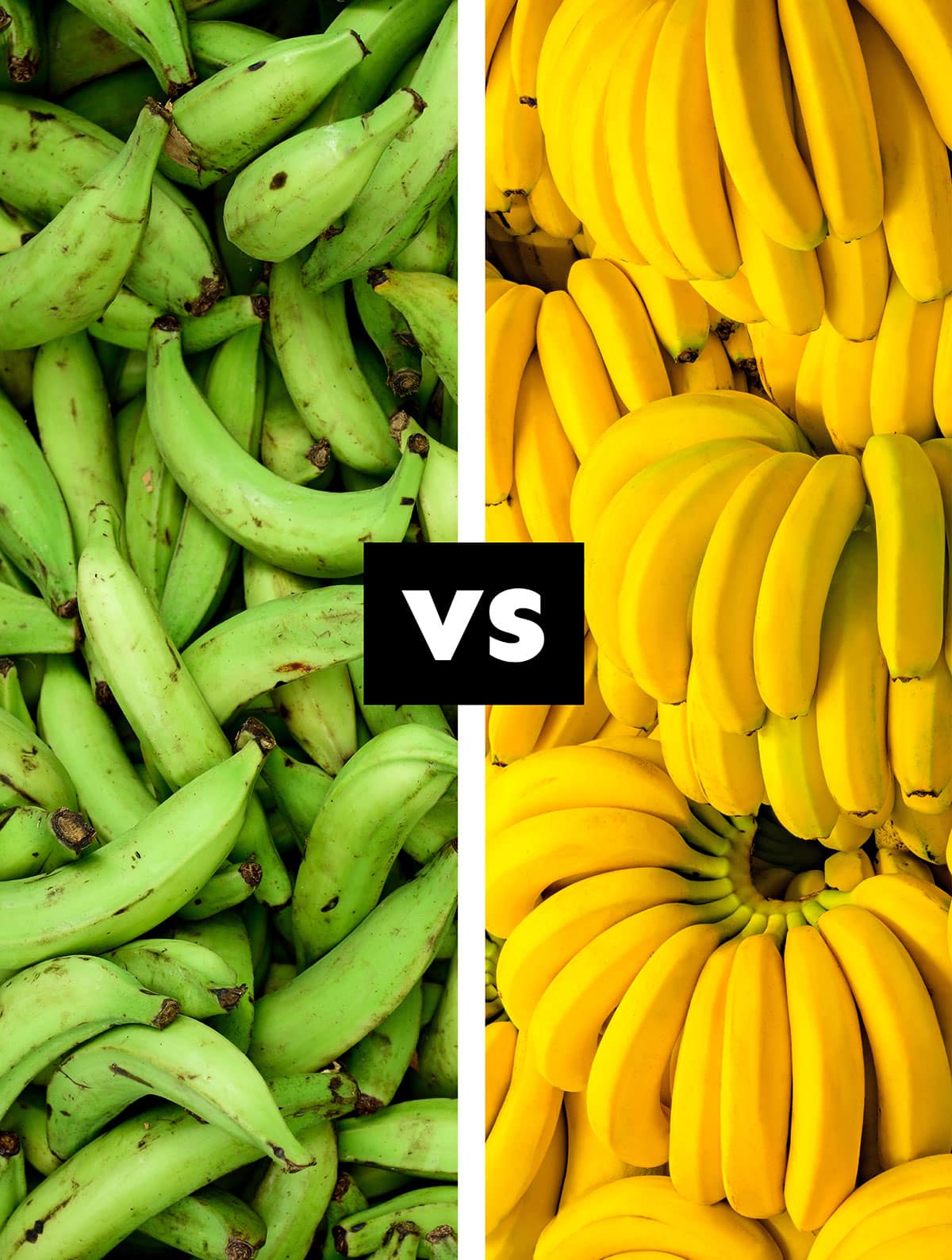
Are bananas and plantains the same thing? Well no, but they are definitely in the same family. The difference between bananas and plantains lies in their flavor, texture, size, where they’re grown, and how they are used. Let’s break it all down.
Appearance
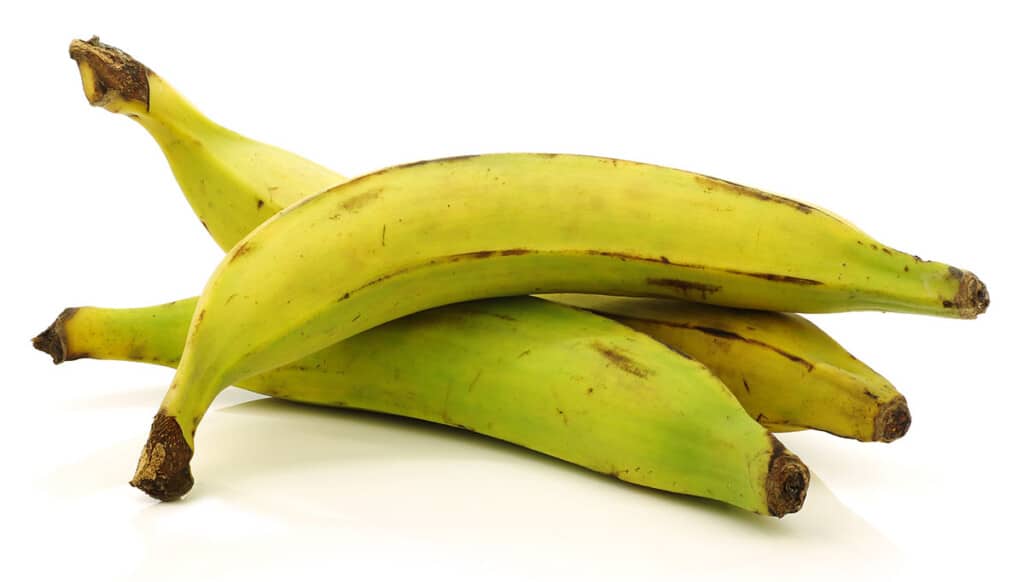
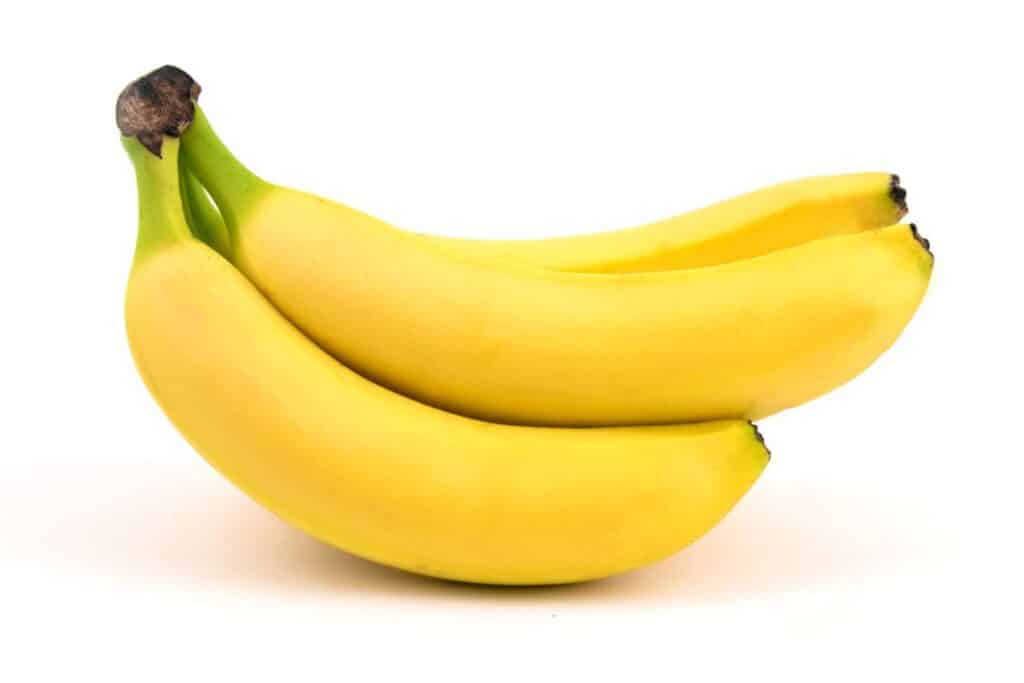
Plantains: These are elongated, thick-skinned fruits that resemble bananas but are larger and have a tougher, less sweet skin. They can vary in size from about 6 to 12 inches long. When ripe, their skin transitions from green to yellow or black, with the color indicating their ripeness.
Bananas: It seems almost absurd to describe bananas to anyone. 96% of American families buy at least one banana a month. Bananas typically have a long, curved shape with a vibrant yellow skin when ripe, although some varieties may be green or even reddish-purple. The fruit is usually about 6 to 8 inches in length and features a peel that is easily removable to reveal the soft, creamy flesh inside. The inner fruit is pale yellow to cream-colored. Bananas are usually smaller than plantains, and have thinner skins.
Flavor & Texture
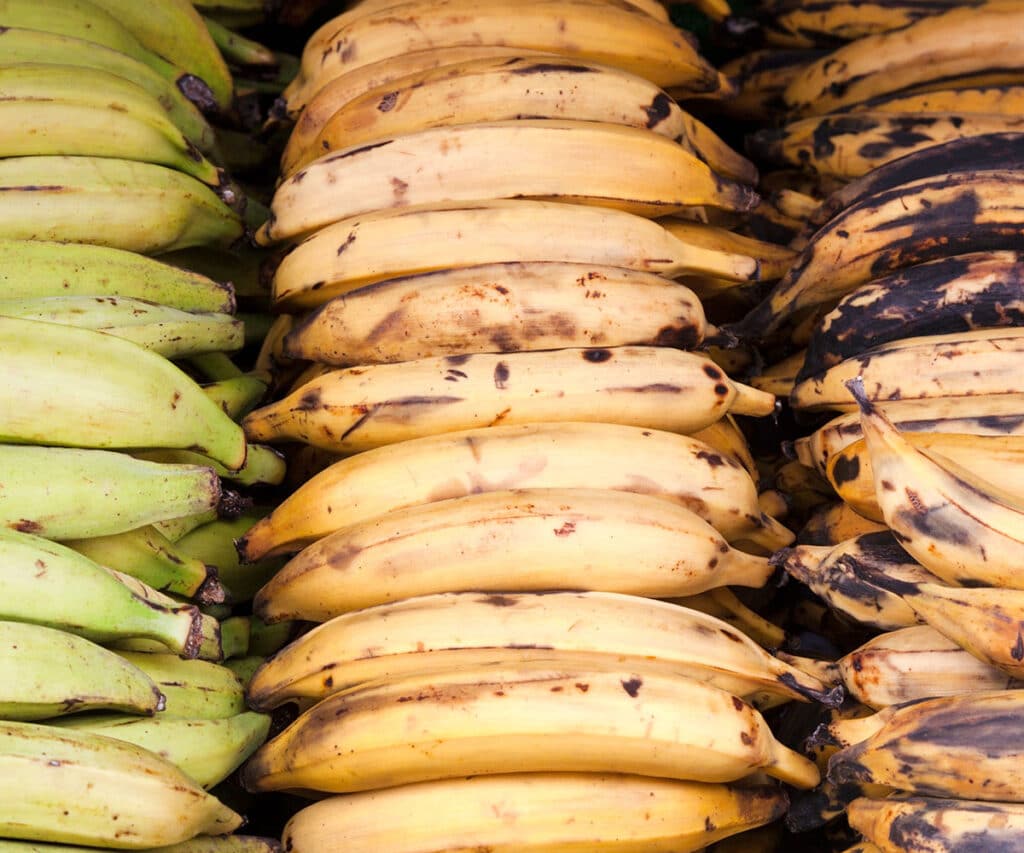
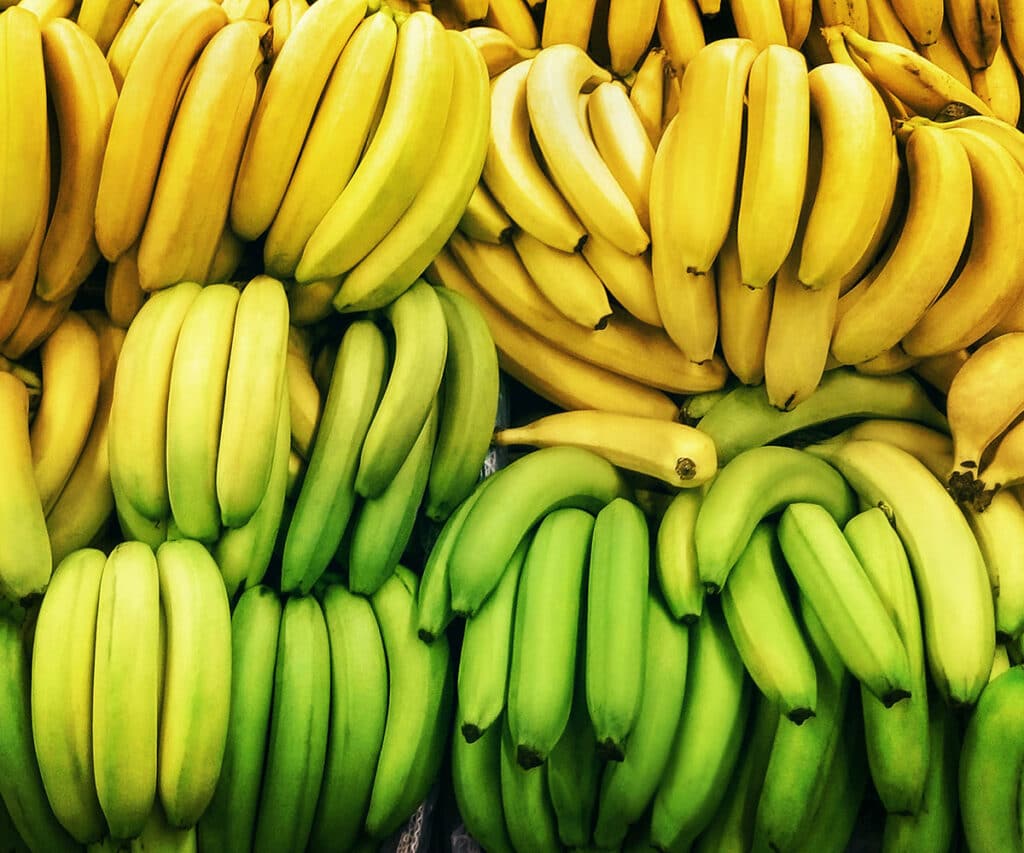
Plantains: The flavor and texture of plantains change as they ripen. Green plantains have a starchy, neutral taste with a slightly nutty undertone. They are starchy and firm, and best suited for cooking methods like frying and boiling. As they ripen and turn yellow, their flavor becomes sweeter, resembling a blend of banana and potato. At this stage, they can be sliced and used in various dishes. Overripe, black plantains are very sweet, almost like a dessert banana. Plantains are starchier and less sweet than bananas.
Bananas: Bananas are known for their naturally sweet and slightly tangy flavor. When fully ripe, they have a rich, tropical taste with notes of honey and hints of citrus. The texture of a ripe banana is smooth and creamy, often described as buttery, and a ripe banana melts in your mouth. However, as bananas ripen further, they can become mushier and sweeter, which many people prefer for use in baking or smoothies.
Uses
Plantains: Green plantains are commonly used to make savory dishes like tostones (fried plantains) or mofongo (a Puerto Rican dish made by mashing green plantains with garlic and other seasonings). Yellow plantains are often fried or baked and served as a side dish like stuffed plantains, or they can be used to make dishes like plátanos maduros, where they are caramelized for a sweet and savory flavor. Overripe, black plantains are perfect for making sweet desserts or snacks like maduros en tentación (sweet ripe plantains in syrup). Consider air fried plantains or grilled plantains for a quick healthy snack
The big difference in plantain use vs banana use is that plantains are used mostly in cooking while bananas are equally as good as a raw snack or in recipes. Plantains tend to be larger than bananas and are eaten ripe or unripe (sweet or savory), while bananas are only eaten when they are ripe and sweet.
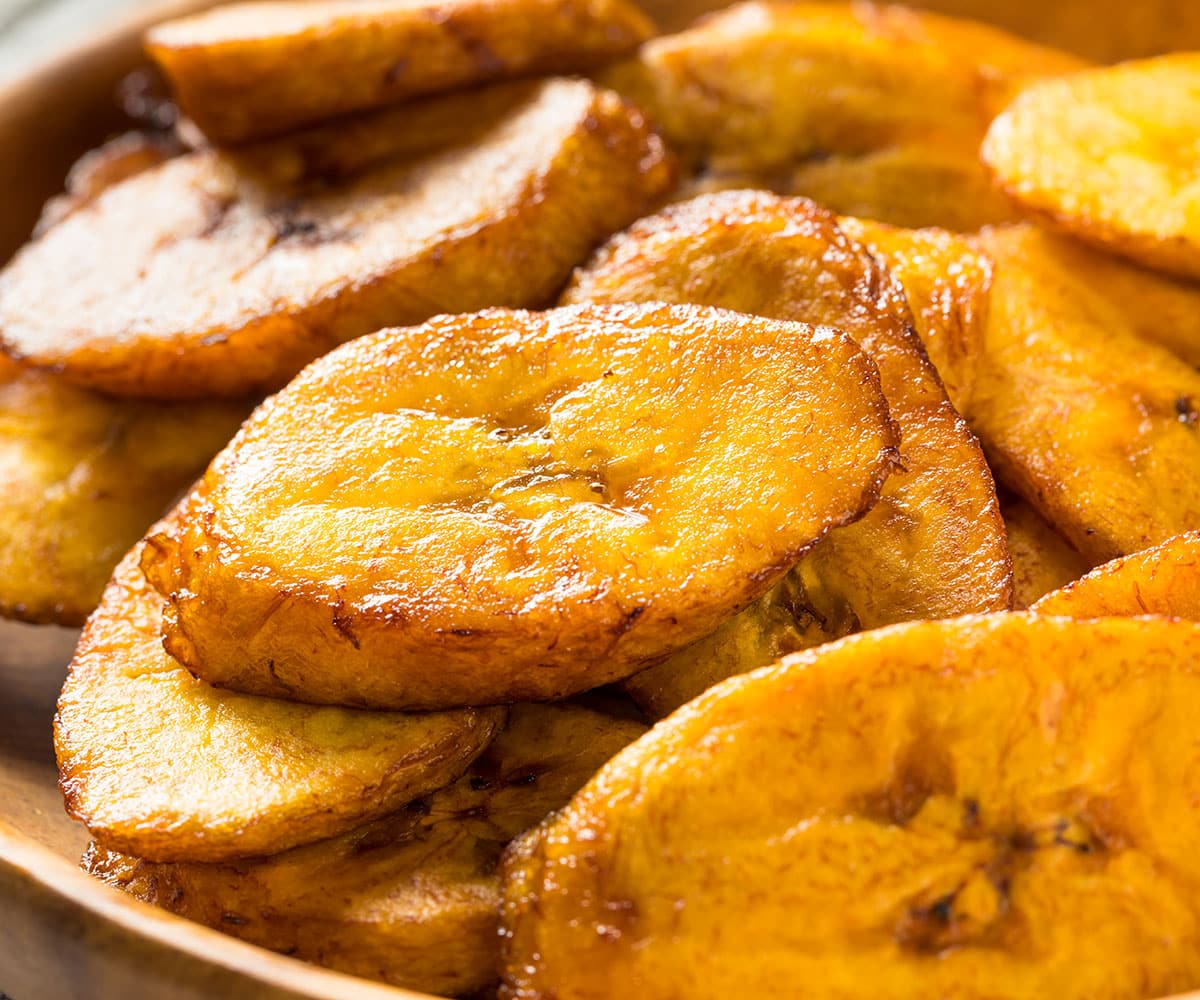
Bananas: Bananas are commonly eaten fresh as a healthy snack or added to breakfast cereals, yogurt, oatmeal, or try these healthy breakfast banana splits . Bananas are a staple ingredient in smoothies, lending natural sweetness and creaminess. They are also a key component in desserts like banana bread, banana pancakes, muffins, and ice cream. In savory dishes, they can be used in tropical salads or grilled to complement meats and vegetables.
There is an almost endless choice of Banana Recipes, but my personal favorite is Almond Butter Baked Bananas. If you aren’t looking to cook, try this simple but decadent Key Lime Pie Smoothie.
And, finally if you haven’t tried the recently popular faux ice cream, try banana nice cream. Trust us on this one. Frozen bananas make a wonderfully healthy ice cream substitute with all the creamy goodness and far fewer calories than ice cream.
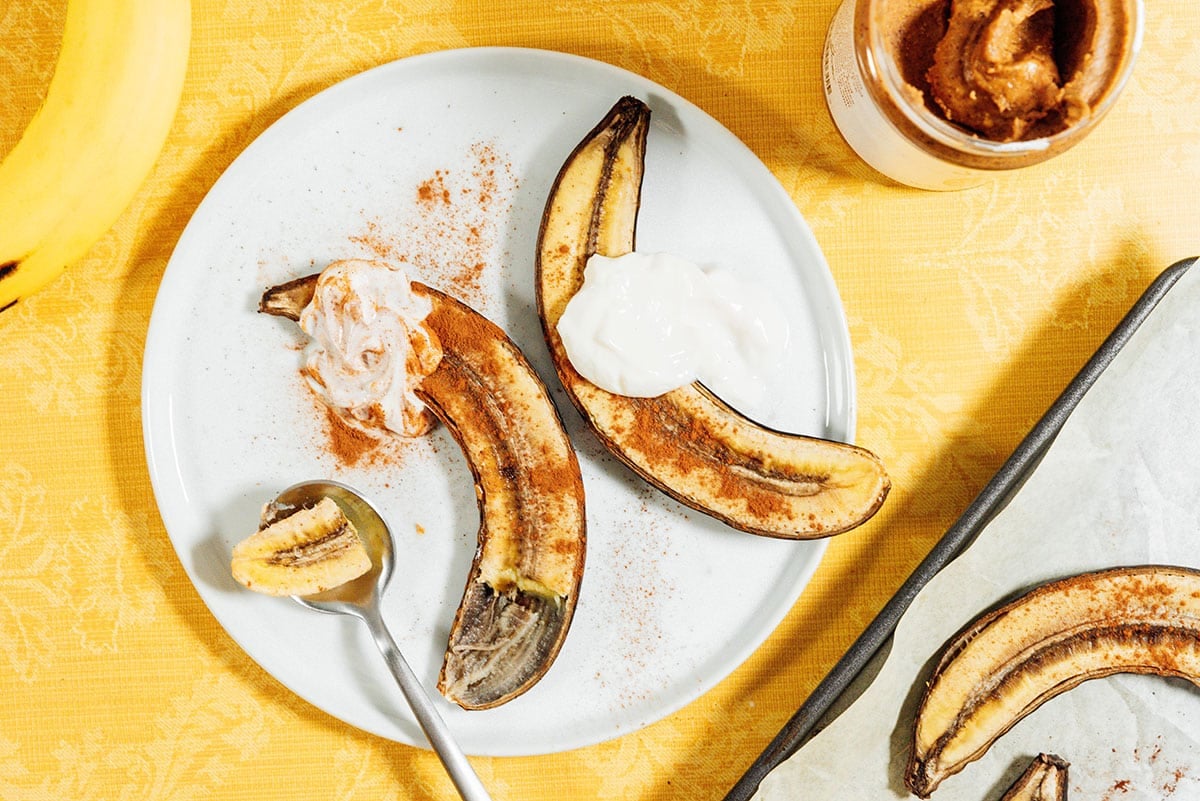
Peeling
We all know how to peel bananas. Grab the end where you broke it from the bunch and bend it until it breaks then peel it down three or four sides to remove the peel. Plantains aren’t quite so easy.
First choose the right plantain! Look for ripe plantains with yellow to black skin. The ripeness depends on your preference and intended use. If you want them firmer and less sweet, choose yellow ones. For sweeter and softer plantains, select those with black spots.
Start by cutting off both ends. Score the skin by making a shallow cut along the length of the plantain, from top to bottom, without piercing the flesh inside. This cut helps you remove the skin more easily. Insert your fingers or a small knife under the scored section and gently lift the skin away from the flesh. Be careful not to damage the plantain pulp. Continue to lift and peel the skin away from the plantain flesh. If the plantain is ripe, the skin should come off fairly easily. You can now slice the peeled plantain into rounds or strips, depending on how you plan to cook it.
Plantain peels are almost always discarded. For most of us it is the same with bananas, but you don’t have to throw out banana peels. They are perfectly edible and a great add to your smoothies giving them an added fiber boost. The sweeter brown peels also serve as a great natural sweetener to your post workout smoothie. A banana’s peel constitutes over ⅓ of a banana’s weight, so why waste it?
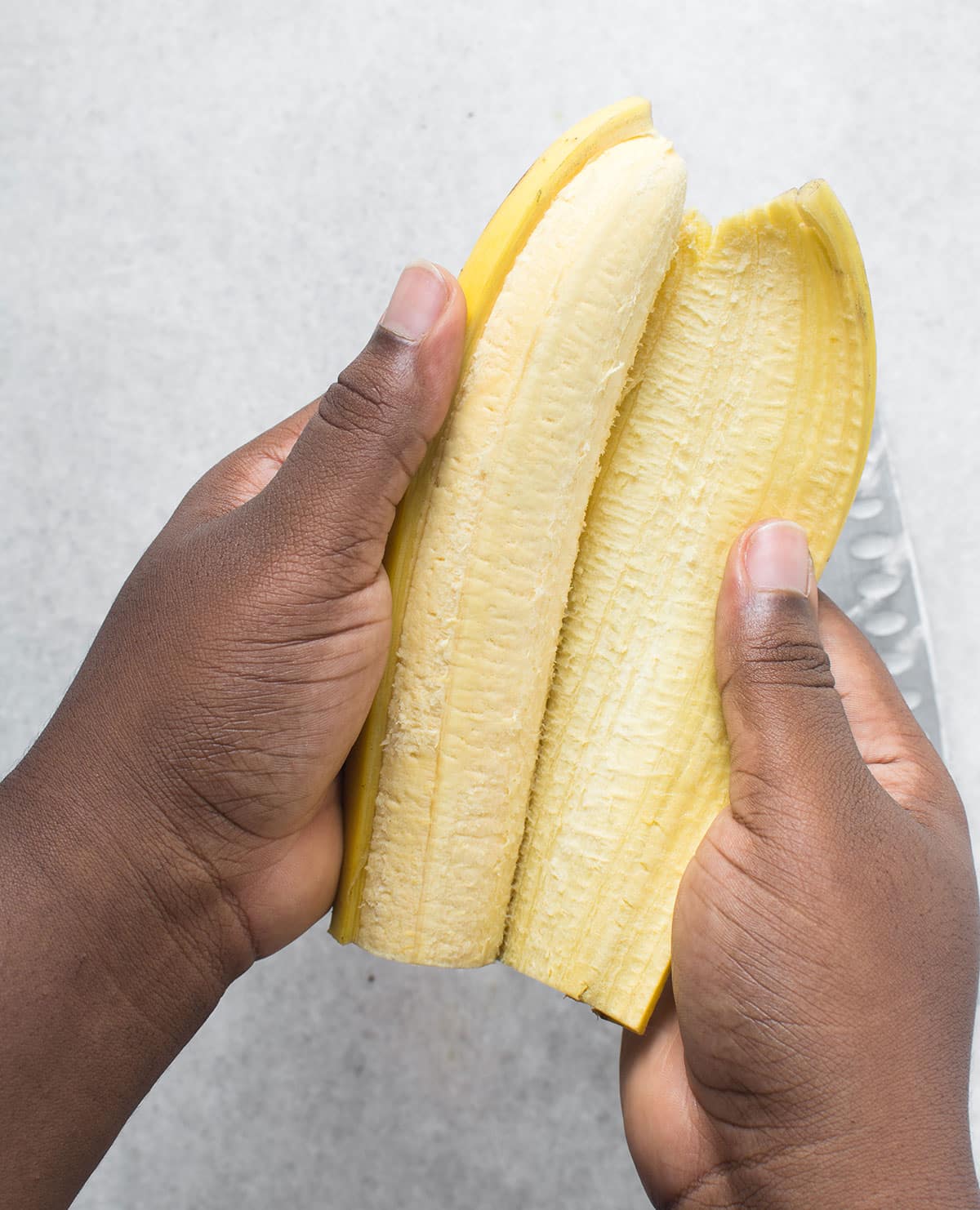
Storage
Plantains: The storage of plantains depends on their ripeness. Green, unripe plantains can be stored at room temperature for up to two weeks. As they ripen, it’s advisable to keep them in a cool, dry place or in the refrigerator to slow down the ripening process. Ripe yellow or black plantains can be stored in the refrigerator for a few days or frozen for longer-term storage. Frozen plantains can be used in cooking without the need for thawing.
Bananas: Store bananas on the counter until you use them. When they start turning brown, peel them (or not) and cut them into pieces. Put all the pieces in a sealable bag and toss them in the freezer. This will assure that you always have bananas at the ready for smoothies, banana bread, you name it. If you want to prevent your bananas from ripening too quickly, separate them indiviually from the bunch, as bananas release natural gasses that can accelerate ripening when kept together.
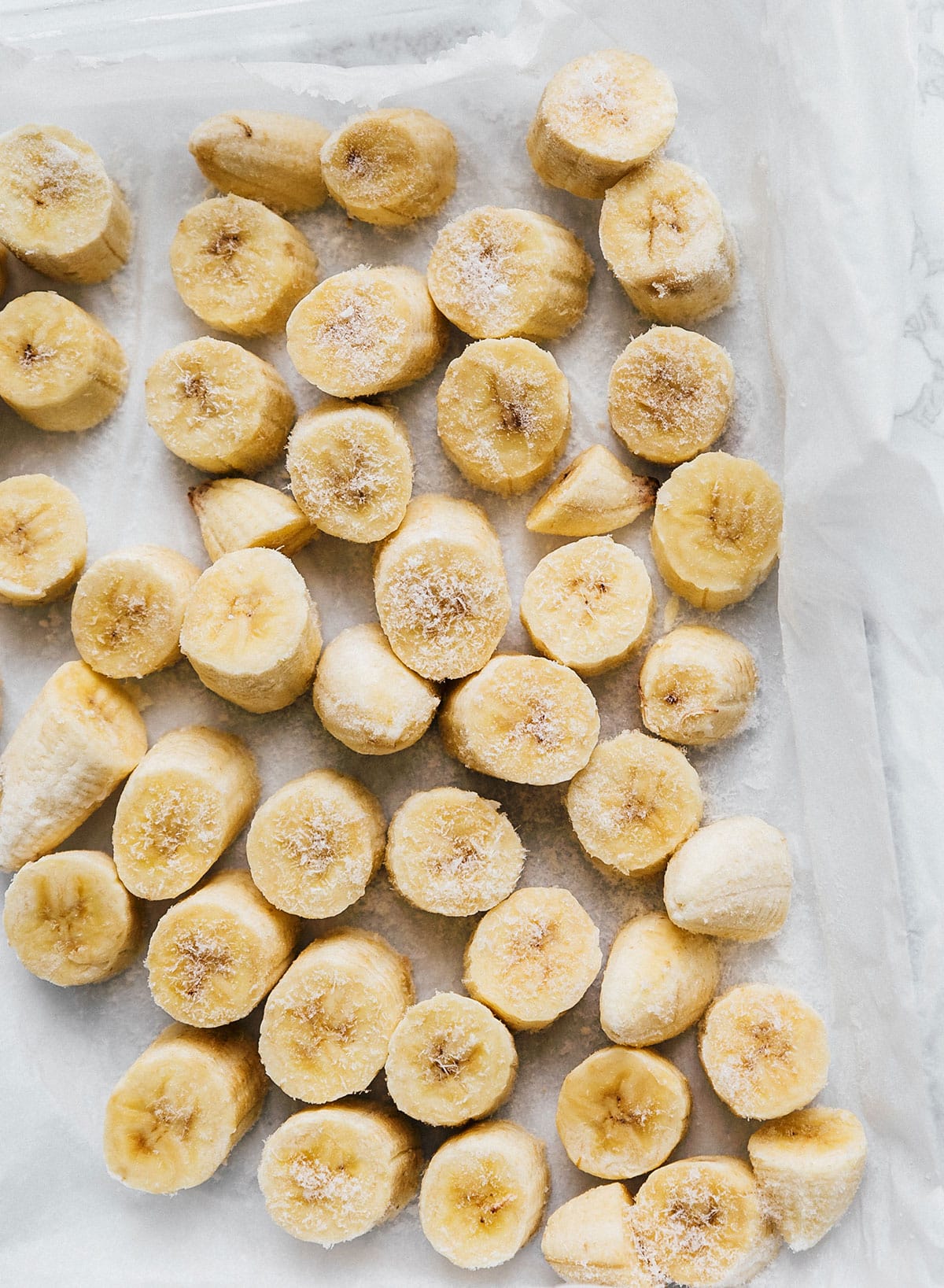
Origin & History
Plantains: We believe plantains originated in Southeast Asia, particularly in regions that include present-day Malaysia and Indonesia, and were likely eaten as long as 4,000 years ago. They spread across the world from there, initially to Africa brought by Arab traders or through trade routes across the Indian Ocean around the 9th century. The fruit thrived in the tropical climates of Africa and quickly became a dietary staple. Over time, various African cultures developed numerous recipes and culinary traditions centered around plantains.
During the era of European colonialism the transatlantic slave trade brought plantains to the Caribbean and the Americas. Plantains were, in effect, introduced to the Americas by enslaved Africans. The fruit adapted well to the tropical and subtropical climates of the Caribbean, Central America, and South America. Plantains became a crucial food source for enslaved Africans and their descendants in these regions.
Today, plantains are cultivated in many tropical and subtropical countries worldwide, but 4 of the top 5 producers are in Africa (Cameron, Ghana, Uganda, and Nigeria). Columbia rounds out the top 5.
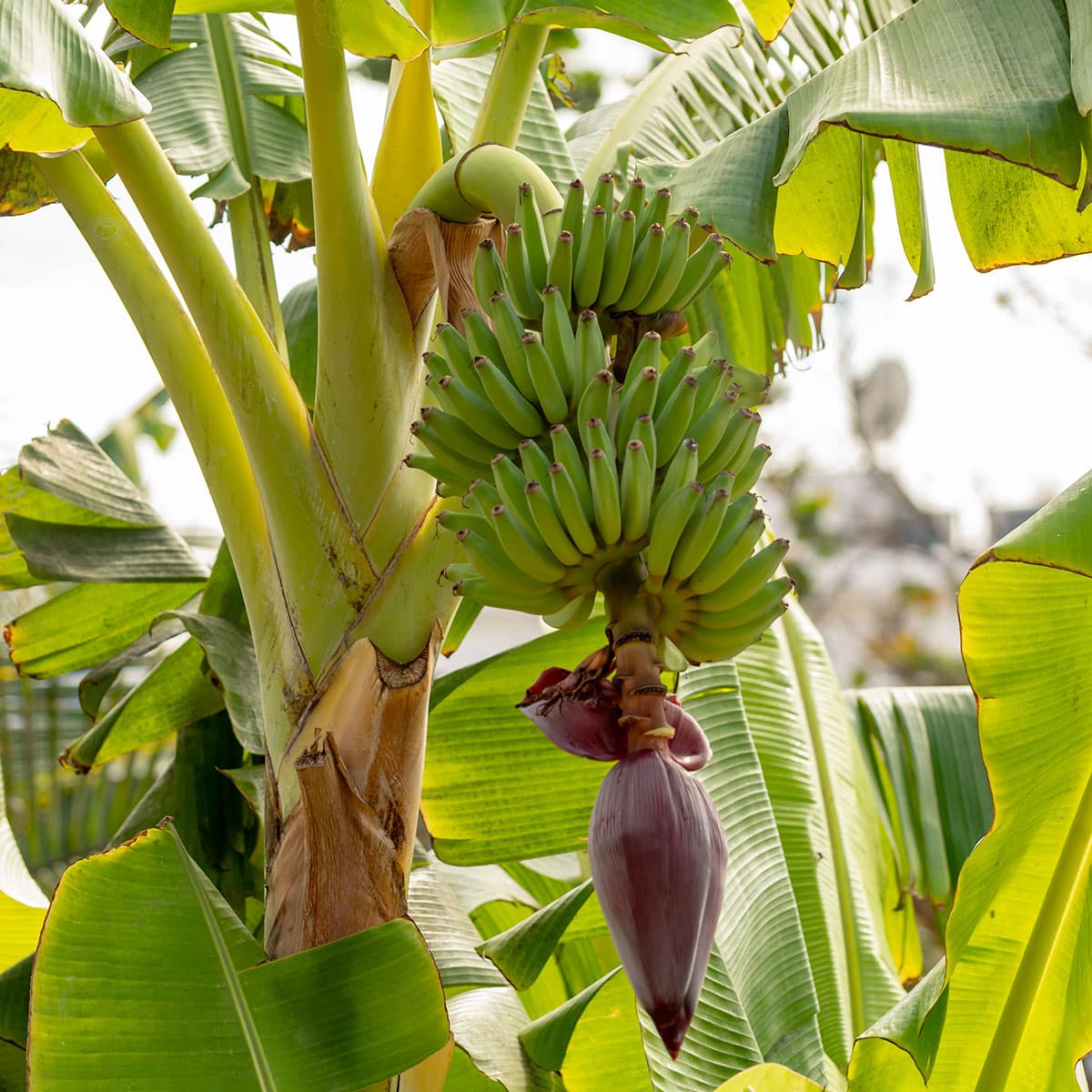
Bananas: The banana family, to which plantains belong, is one of the oldest cultivated plants. Bananas were likely first domesticated in Papua New Guinea around 7,000 to 10,000 years ago. From there, they spread to other parts of Southeast Asia and eventually reached the Indian subcontinent. Historical records suggest that bananas were cultivated in India as early as 2000 BCE. They are mentioned in ancient Indian texts like the Ramayana and the Mahabharata. They were also grown in ancient Egypt and spread across Africa likely 2,000 years ago.
European explorers and traders encountered bananas during their travels in Africa and Asia, and Portuguese sailors are believed to have brought bananas to the Atlantic islands of Madeira and the Canary Islands in the early 16th century. In the 19th century, commercial banana cultivation began in earnest in Central and South America, primarily in countries like Honduras, Costa Rica, and Colombia. This period also saw the rise of companies like the United Fruit Company (now Chiquita Brands International) and the Standard Fruit Company (now Dole Food Company), which played a significant role in development of the banana industry.
Today, bananas are grown in tropical and subtropical regions around the world. The world’s leading producers are India, China, Indonesia, Brazil, Thailand, Ecuador, and the Philippines though there is also substantial production in Colombia, Costa Rica, Ecuador, Guatemala, Honduras, Mexico, Nicaragua, Panama, and Peru. The Cavendish variety is the most commonly grown banana globally, although there are numerous other banana varieties with distinct flavors and characteristics.
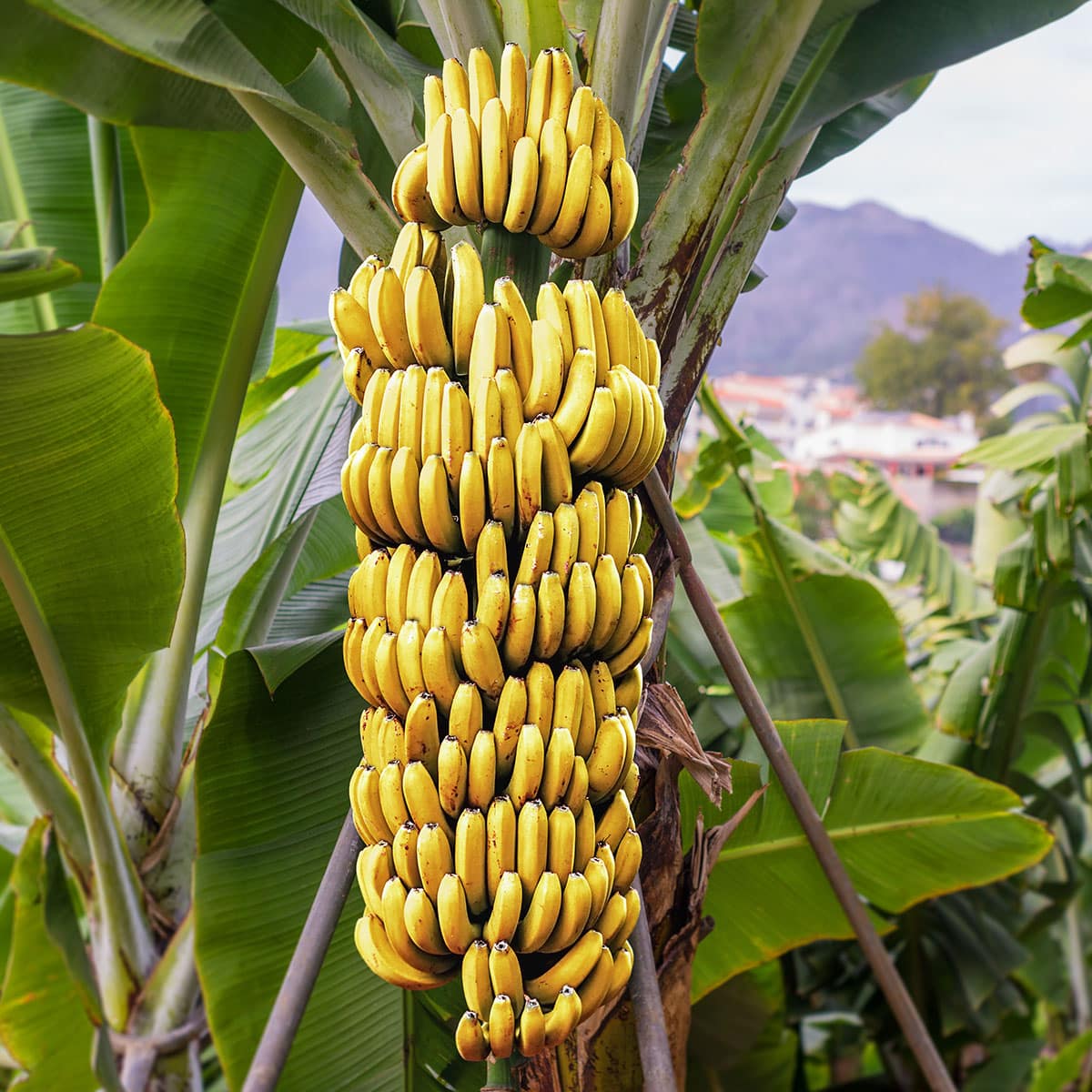
Types
Types Of Plantains
Green Plantains: Green plantains are unripe and have a starchy, firm texture. They are usually cooked before eating and are commonly used in savory dishes. They can be fried, boiled, mashed, or baked to make dishes like tostones (fried plantains), mofongo (fried and mashed green plantains), and plantain chips.
Yellow Plantains: Yellow plantains are partially ripe and have a slightly sweeter taste than green plantains. They are still relatively firm and are often used in both savory and sweet dishes. Yellow plantains can be fried, boiled, or baked and are popular in dishes like maduros (sweet fried plantains) and plantain porridge.
Black Plantains: Black plantains are fully ripe and have a soft, sweet flesh. They are often used in desserts and can be eaten raw when fully ripe. They are commonly used in dishes like plantain fritters, plantain bread, or simply as a sweet snack.
Horn Plantains: Horn plantains are a specific variety known for their elongated, curved shape. They are typically used when they are partially ripe, with yellow or slightly blackened skin. They are versatile, and can be used in culinary applications similar to yellow plantains.
Burro Plantains: Burro plantains are another variety known for their thick, green skin. They are usually less sweet than other types of plantains, even when ripe, making them suitable for savory dishes. They are often used in traditional Latin American recipes like carne con plátanos (meat with plantains).
Macho Plantains: Macho plantains are a type of plantain that is smaller and sweeter when fully ripe than other plantains, and are commonly used in sweet plantain dishes.
Pisang Awak or Dwarf Cavendish: While not technically plantains, dwarf cavendish are known for their sweet flavor. They are often confused with plantains because they are similar in appearance. These bananas are sweeter and less starchy than true plantains, and thus commonly eaten as a dessert fruit.
Hawaiian Plantains: This Hawaiian variety is often called “Hawaiian Apple Bananas” or “Hawaiian Candy Bananas.” They are smaller and sweeter than traditional plantains, and are often eaten fresh or used in desserts and baked goods due to their sweet flavor.
Cuban Plantains: Plantains are a common ingredient in Cuban cuisine and are known as “plátanos” in Spanish. They are typically fried, smashed, or used to make dishes like tostones (fried green plantains) and maduros (sweet ripe plantains).
Jamaican Plantains: In Jamaica, plantains are called “green bananas” or “plátanos.” They are used in various dishes, such as “jamaican patties” where they are used as a filling, and in dishes like “plantain porridge” and “plantain tarts.” Plantains are also commonly fried or used as boiled plantains and served as a side dish.
Haitian Plantains: Plantains are a staple food in Haitian cuisine and are known as “bannann.” Tostones (fried plantains) bananes pesées (sweet ripe plantains) are popular dishes in Haiti where plantains are often served as a side dish or as an accompaniment to stews and meats.
Nigerian Plantains: Plantains are a dietary staple in Nigeria, the world’s 5th largest producer, and are referred to as “dodo” or “boli”. Nigerian plantains are used to make a variety of dishes, including fried plantains (dodo), plantain chips (kpekere), and plantain porridge. Ripe plantains are also used in Nigerian desserts like plantain cake.
Types of Bananas
There are quite literally hundreds of banana varieties across the world, and we won’t try to list them all here as we have a whole separate article on Types of Bananas. So, if you are looking for more on different banana varieties check it out. There is, however, one type of banana that dominates the world market, and that is the Cavendish. Cavendish bananas account for 50 million tons of the 116 million tons produced worldwide every year and are by FAR the most eaten banana in the United States. This was not always the case.
The Big Mike banana dominated the US market until the 1920s when a blight caused by the Panama wilt disease greatly curtailed production of the Big Mikes. By the 1960s the big banana companies knew they had to make a change, so they adjusted and focused on the Cavendish, and why not? They are now the bananas we all love.
Nutrition
Banana and plantain nutrition content is pretty comparable. Neither is a low calorie food option, nor a good source of protein. They both, however, provide a respectable amount of fiber, vitamins, and minerals.
Bananas are often used by athletes as a post or during workout energy supplement. They are often used by distance runners as an electrolyte replacement food, but few people really know what that means. Electrolytes are substances that conduct electricity when they dissolve in water (to include the water in your body). These are present in essential minerals to include Sodium, Potassium, Magnesium, Calcium, and Chloride. Gatorade really only provides sodium which the USDA says most of us get too much of in our diet. Bananas, however, are a good source of potassium and magnesium. There is a good reason bananas are so often used as a post workout snack.
FAQs
How many carbs in plantains? According to the USDA, a cup of sliced plantains contains 32g of carbs.
Are plantains Keto Friendly? No, not at all. Given the 32g of carbs mentioned above, plantains will push you out of ketosis very quickly.
Are plantains Gluten Free? Yes, Plantains are naturally gluten-free.
Is plantain a fruit or vegetable? It is a fruit. This may seem a silly question, but given that tomatoes, zucchini, pumpkins, and cucumbers are all botanically fruits, it is actually a fair question. Technically plantains are actually berries. Botanically a berry is a fruit having seeds and fleshy pulp produced from the ovary of a single flower. Go figure!
Do plantains taste like bananas? Plantains are not as sweet and starchier than bananas, but the more ripe they become the sweeter they get.
Can you air fry plantains? Absolutely. Air fried plantains are a quick healthy snack or side dish. This is a simple method you can use:
- Lightly brush or spray them with a small amount of cooking oil. This step is optional but helps achieve a crispy texture.
- Place the plantain slices or chunks in a single layer in the air fryer basket. Avoid overcrowding to ensure even cooking. You may need to cook them in batches if you have a lot of plantains.
- Set the air fryer to 375°F (190°C) and cook the plantains for 8-12 minutes, flipping or shaking the basket halfway through the cooking time. The exact cooking time may vary depending on the thickness of the slices and the air fryer model, so keep an eye on them.
- The plantains should turn golden brown and become crispy on the outside. They should also be tender on the inside. If needed, you can cook them for a little longer for extra crispiness.
- Season with salt, cinnamon, chili powder, or your favorite seasoning to get the flavor you want.
To wrap up, bananas and plantains are botanically related, and look similar. There are, however, distinct differences in their appearance, flavor, texture, and best uses. Bananas are smaller with a thinner skin, but have a softer & sweeter pulp.
This wraps our look at plantains vs bananas. We hope you found a recipe or information here you can use, and as always happy cooking!
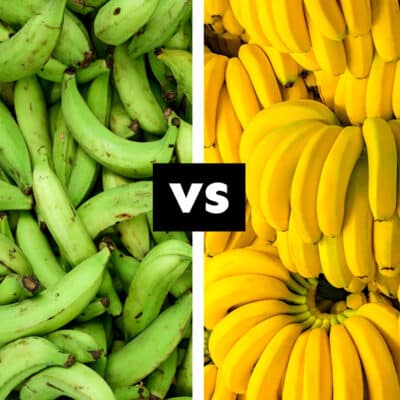
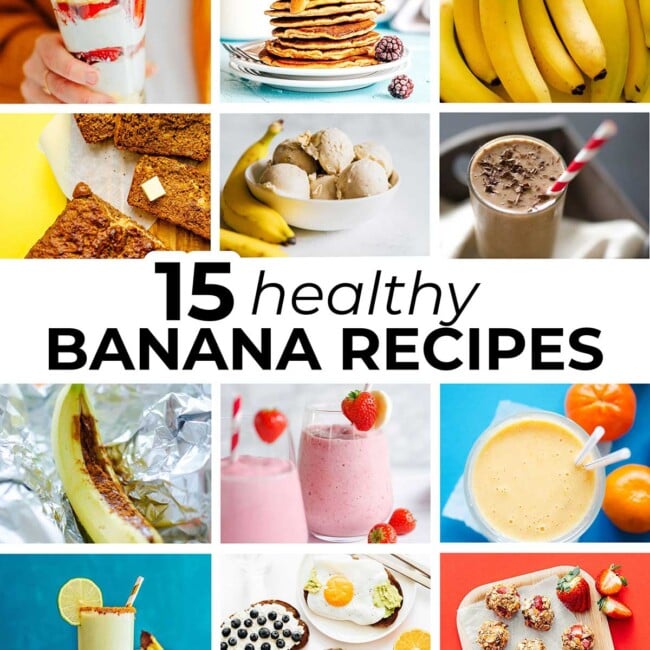
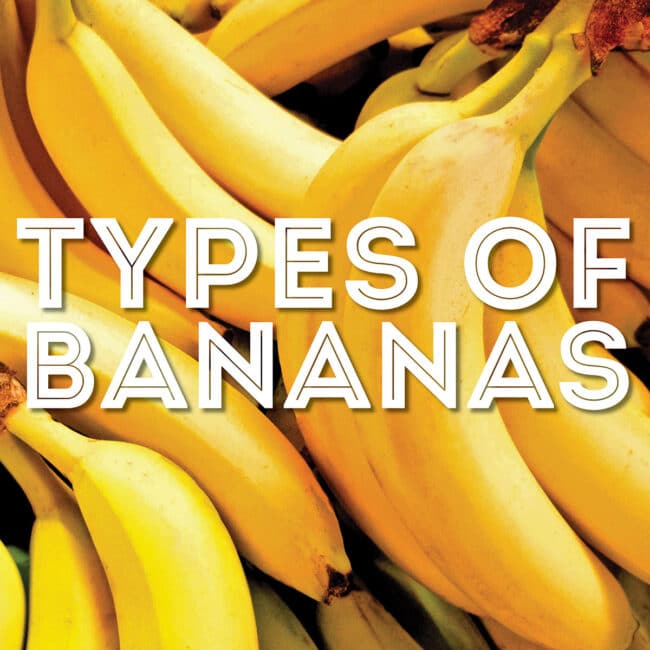
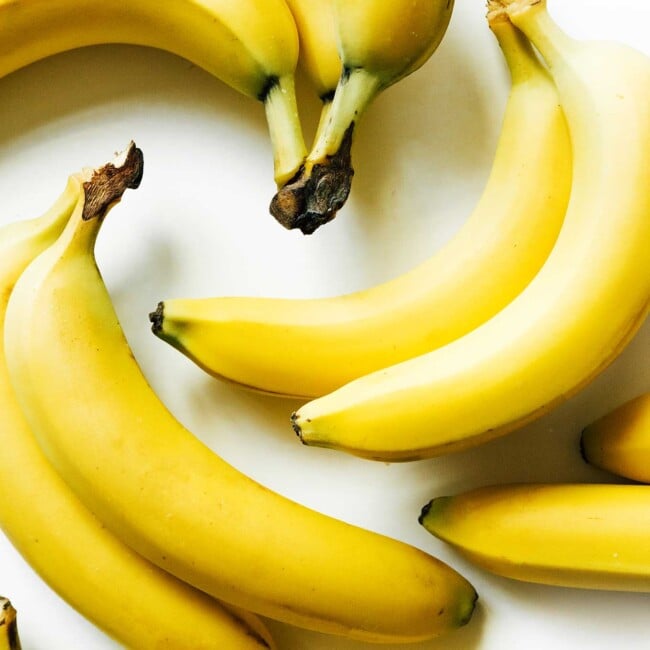
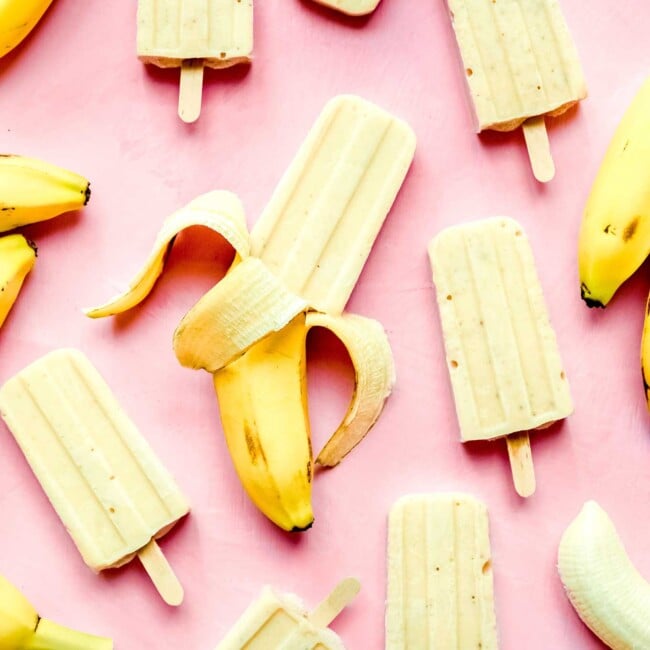
Leave a Comment